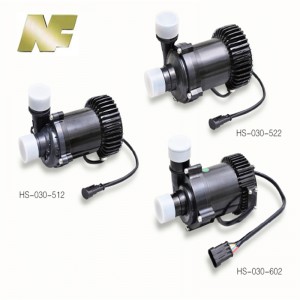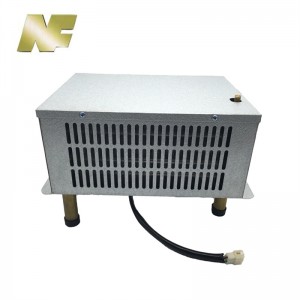The comprehensive thermal management of fuel cell bus mainly includes: fuel cell thermal management, power cell thermal management, winter heating and summer cooling, and the comprehensive thermal management design of the bus based on the utilization of fuel cell waste heat.
The core components of fuel cell thermal management system mainly include: 1) Water pump: drives coolant circulation. 2) Heat sink (core + fan): reduces coolant temperature and dissipates fuel cell waste heat. 3) Thermostat: controls coolant size circulation. 4) PTC electric heating: heats coolant at low temperature start to preheat the fuel cell. 5) Deionization unit: absorbs ions in coolant to reduce electrical conductivity. 6) Antifreeze for fuel cell: the medium for cooling.
Based on the characteristics of fuel cell, the water pump for thermal management system has the following characteristics: high head (the more cells, the higher the head requirement), high coolant flow (30kW heat dissipation ≥ 75L/min) and adjustable power. Then the pump speed and power are calibrated according to the coolant flow.
The future development trend of electronic water pump: under the premise of satisfying several indexes, the energy consumption will be reduced continuously and the reliability will be increased continuously.
The heat sink consists of a heat sink core and a cooling fan, and the core of the heat sink is the unit heat sink area.
The development trend of radiator: the development of a special radiator for fuel cells, in terms of material improvement, required to enhance the internal cleanliness and reduce the degree of ion precipitation.
The core indicators of the cooling fan are fan power and maximum air volume. 504 model fan has a maximum air volume of 4300m2/h and rated power of 800W; 506 model fan has a maximum air volume of 3700m3/h and rated power of 500W. Fan is mainly.
Cooling fan development trend: cooling fan can subsequently change in the voltage platform, directly adapt to the voltage of the fuel cell or power cell, without the DC/DC converter, to improve efficiency.
PTC electric heating is mainly used in the low temperature start-up process of fuel cell in winter, PTC electric heating has two positions in the fuel cell thermal management system, in the small cycle and in the make-up water line, the small cycle is the most common.
In winter, when the low temperature is low, the power is taken from the power cell to heat the coolant in the small cycle and the make-up water pipeline, and the hot coolant then heats up the reactor until the temperature of the reactor reaches the target value, and the fuel cell can be started and the electric heating is stopped.
PTC electric heating is divided into low-voltage and high-voltage according to the voltage platform, low-voltage is mainly 24V, which needs to be converted to 24V by DC/DC converter. low-voltage electric heating power is mainly limited by the 24V DC/DC converter, at present, the maximum DC/DC converter for high-voltage to 24V low-voltage is only 6kW. The high voltage is mainly 450-700V, which matches the voltage of the power cell, and the heating power can be relatively large, mainly depending on the volume of the heater.
At present, the domestic fuel cell system is mainly started by external heating, i.e., warming up by PTC heating; overseas companies such as Toyota can start directly without external heating.
The development direction of PTC electric heating for fuel cell thermal management system is miniaturization, high reliability and safe high voltage PTC electric heating.



Post time: Mar-28-2023




